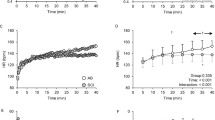Abstract
The purpose of this study was to examine whether arm cranking exercise induces changes in skin blood flow in the paralyzed lower limbs of people with injuries to the spinal cord (PISC). Ten PISC with lesions located between Th5 and L5 and six control subjects performed arm cranking exercise for 6 min at three intensities, 10, 30 and 50 W, at a room temperature of 25°C. Oxygen uptake (Vo2) and heart rate (HR) were measured for the last 2 min of each exercise period. The skin blood flow at the anterior thigh (BFsk,t) was continuously monitored using laser Doppler flowmetry for the whole 6-min period and for the first 10 min of recovery following exercise. During exercise, the PISC showed lower Vo2 and greater HR than the control subjects. No increase in BFsk,t was found in six of the PISC with lesions at or above Th12, irrespective of the exercise intensity. On the other hand, in PISC with lesions at L1 or below, BFsk,t increased significantly (P < 0.05) with an increase in Vo2 and HR, although the BFsk,t at a given Vo2 and HR was lower than that in the control subjects. These results would suggest that arm exercise can promote the blood circulation in the skin of the lower limbs if the injury level is below L1.
Similar content being viewed by others
References
Attia M, Engel P (1993) Thermoregulatory setpoint in patients with spinal cord injuries (spinal man). Paraplegia 21:233–248
Bidart Y, Maury M (1973) The circulatory behaviour in complete chronic paraplegia. Paraplegia 11:1–24
Cooper KE, Ferres HM, Guttmann L (1957) Vasomotor responses in the foot to raising body temperature in the paraplegic patient. J Physiol 136:547–555
Curtis KA, Hall KM, McClanahan S, Dillon D, Brown KF (1986) Health, vocational and functional status in spinal cord injured athletes and nonathletes. Arch Phys Med Rehabil 67:862–865
Fuhrer MJ, Garber SL, Rintala DH, Clearman R, Hart KA (1993) Pressure ulcers in community-resident persons with spinal cord injury: prevalence and risk factors. Arch Phys Med Rehabil 74:1172–1177
Guttman L, Silver J, Wyndham CH (1958) Thermoregulation in spinal man. J Physiol 142:406–419
Hammel HT, Jackson DC, Stolwijk JAJ, Hardy JD, Strømme SB (1963) Temperature regulation by hypothalamic proportional control with an adjustable set point. J Appl Physiol 18:1146–1154
Hjeltnes N (1977) Oxygen uptake and cardiac output in graded arm exercise in paraplegics with low level spinal lesions. Scand J Rehab Med 9:107–113
Hopman MTE, Oeseburg B, Binkhorst RA (1992) Cardiovascular responses in paraplegic subjects during arm exercise. Eur J Appl Physiol 65:73–78
Hopman MTE, Verheijen PHE, Binkhorst RA (1993) Volume changes in the legs of paraplegic subjects during arm exercise. J Appl Physiol 75:2079–2083
Irizawa M, Yamasaki M, Muraki S, Komura T, Seki K, Kikuchi K (1994) Relationship between heart rate and oxygen uptake during submaximal arm cranking in paraplegics and quadriplegics. Ann Physiol Anthropol 13:275–280
Ishii K, Yamasaki M, Muraki S, Komura, T, Kikuchi K, Maeda K (1994) Exercise-induced temperature changes in the tympanic membrane and skin of patients with spinal cord injury. In: Yabe K, Kusano K, Nakata H (eds) Adapted physical activity, Springer-Verlag, Tokyo, pp 77–83
Johnson JM, Rowell LB (1975) Forearm skin and muscle vascular responses to prolonged leg exercise in man. J Appl Physiol 39:920–924
Johnson JM, Taylor WF, Shepherd AP, Park MK (1984) Laser-Doppler measurement of skin blood flow: comparison with plethysmography. J Appl Physiol 56:798–803
Kenny WL, Johnson JM (1992) Control of skin blood flow during exercise. Med Sci Sports Exerc 24:303–312
Kinzer SM, Convertino VA (1989) Role of leg vasculature in the cardiovascular response to arm work in wheelchair-dependent populations. Clin Physiol 9:525–533
Normell LA (1974) Distribution of impaired cutaneous vasomotor and sudomotor function in paraplegic man. Scand J Clin Lab Invest 33 (Suppl. 138):25–41
Saumet JL, Kellogg DL Jr, Taylor WF, Johnson JM (1988) Cutaneous laser-Doppler flowmetry: influence of underlying muscle blood flow. J Appl Physiol 65:478–481
Wenger CB, Roberts MF, Stolwijk JAJ, Nadel ER (1975) Forearm blood flow during body temperature transients produced by leg exercise. J Appl Physiol 38:58–63.
Yamasaki M, Komura T, Fujiie K, Sasaki H, Kai K (1994a) Are there benefits of sports participation in the prevention of pressure sores in spinal cord injured persons? Jpn J Phys Fitness Sports Med 43:121–126.
Yamasaki M, Komura T, Fujiie K, Sasaki H, Kai K, Ohdoko K (1994b) Development of pressure sores in active and inactive persons with spinal cord injury. In: Yabe K, Kusano K, Nakata H (eds) Adapted physical activity, Springer-Verlag, Tokyo, pp 62–67
Author information
Authors and Affiliations
Rights and permissions
About this article
Cite this article
Muraki, S., Yamasaki, M., Ishii, K. et al. Effect of arm cranking exercise on skin blood flow of lower limb in people with injuries to the spinal cord. Europ. J. Appl. Physiol. 71, 28–32 (1995). https://doi.org/10.1007/BF00511229
Accepted:
Issue Date:
DOI: https://doi.org/10.1007/BF00511229




